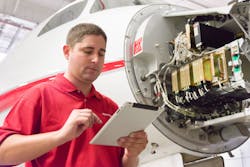Requiring neither a crystal ball nor deck of cards, predictive maintenance has for years loomed as the technology with the potential to completely change the way aviation maintenance is thought about and undertaken. Yet the tech has been mostly a buzz phrase, both too young and not widely enough implemented to really shift the landscape. Preventative and cycle hour-based maintenance are still the mainstays. But the experts agree — predictive maintenance is advancing and it won’t be long for its potential to be realized.
But what does predictive maintenance mean? It’s easy for it to be conflated with preventative maintenance, where a possible problem is corrected before it can become reality. Preventative maintenance is founded on the same basic principle — preventing possible and likely problems — but as John Peterson, vice president and general manager of software and services at Honeywell described, preventative maintenance is the evolution of that principle.
“What we're doing is we're saying, ‘Hey look, in terms of this particular area of the aircraft, we want to anticipate a problem is going to happen before it happens. And, it's not because of the number of hours or the number of cycles, which was the traditional way of monitoring and maintaining,’” Peterson said. “What we do in predictive maintenance is a much more sophisticated way of looking at and anticipating a problem. And really, this has to do with the maturity of the technology over time.”
“The aviation industry is many decades beyond the ‘run to failure’ ethos, and successful predictive maintenance is, by definition, preventative maintenance — analyzing and predicting failure and when to pre-emptively intervene in time to prevent failure,” James Elliott, principal business architect, aerospace and defense, IFS, added. “However, it has the ability to intelligently and accurately predict when, and on what asset, system or part maintenance should be performed, unlike preventative maintenance, which is often performed far too early and in the worst cases, not in time.”
Say an aircraft has a pump with the tendency to fail after 300 hours. The standard is to replace the pump prior to what it's usual failure point is — but there’s something behind the failure either causing it or indicating failure is imminent. Predictive maintenance signals to technicians that this otherwise unseen indicator is taking place.
“We notice now that right before that pump fails that there's a spike in the voltage that that pump needs. And we notice once that spike in voltage happens, we can see that within four, eight, ten days of that, the pump ultimately fails. And then the variability occurs based upon when that voltage spike occurs. And so, we write an algorithm around that and rather than the pump having to be pulled every 300 hours, we know that the pump doesn't need to be pulled until we see the voltage spike,” Peterson described.
Extrasensory Perception
Data and information are at the heart of predictive maintenance and getting that data requires aircraft be equipped with the right sensors in the right places.
“The concept has been around for a while now, however, it got propelled around the introductions of the B787 and A350. Both aircraft types introduced far more sensor data from systems and components on the aircraft than any other type prior to that,” Sander de Bree, founder and CEO of EXSYN Aviation Solutions, said. “This jumpstarted the pursuit in aviation to use this onboard data for condition monitoring purposes and subsequently derive prediction models from this that could indicate likeliness of component failures.”
Elliott contrasts the improved data collection to a traditional, hand written logbook where information can only be seen serially by one person at a time.
“Handwritten entries are not searchable, cannot be used in analytics and cannot be mined for information. All the data inside a logbook is dark — useless,” Elliott said. “Now, if we introduce an electronic, connected logbook, it can be used by multiple people at the same time, from anywhere. A mechanic can see what faults are on the aircraft, arrange for proper parts and tools and be productive the moment he gets to the aircraft. And, of course, that digital data can be aggregated and mined. The Internet of Things (IoT) will also help, with sensors being used to measure and collect data.”
Elliott added that according to a 2016 Oliver Wyman MRO Survey, the global fleet of commercial aircraft could generate a massive 98 million terabytes of data per year by 2026.
The IFS Maintenix predictive maintenance solution was utilized by the U.S. Navy in the 90’s to crunch through engine health monitoring data to model and predict the failure of engine components. Today, IFS supports airline customers to automatically update predicted maintenance deadlines for every life-limited component inside their Trent engines, in collaboration with Rolls-Royce and its Blue Data Thread digital strategy.
Within the EXSYN data operations platform, EXSYN offers a solution that they call the AOG risk monitor, said de Bree. “AOG, meaning Aircraft On Ground. This solution uses machine learning models in order to visualize the risk existing on aircraft running into AOG events due to unscheduled component removals. This tool is mainly used by airline maintenance control in order to support preventive/predictive maintenance decision on the aircraft,” said de Bree.
Honeywell’s predictive maintenance platform — Honeywell Forge — is an end-to-end solution. “We can capture data on the aircraft. We have products in terms of sensors and gateways. And, we can aggregate that on the aircraft,” said Peterson. “We also can create connections with the airline data centers through APIs. What we do is we bring over data to be organized and processed that the airline determines is data they want to share with us for their exclusive purpose. And then, what we do is we parse and create an ontology or a standardized method of analyzing that data
“Then, what we do is we create algorithms and we process that data and then we create a user experience so they can interact with their data and they can get easy buttons, simple solutions. And then we also have a notification engine that provides them insights and actions and activities that need to occur in real time. And so, we have the solution completely end-to-end. We call that Honeywell Forge,” Peterson continued.
Of course, collecting all of the data need to make predictive maintenance feasible goes back to the need for sensors in the aircraft, which Peterson said is on of the hurdles holding back the technology from taking off.
“When you talk about a 737, it's an older design that has very few sensors, that has a number of areas where we would like to see more data coming off the aircraft,” Peterson said. “You take a look at something like a triple seven, it has numerous generations associated with it and so it's different for each generation. And then you take a look at something like an Airbus A350 or a 787, it's more of latest generation and so there's not as much that is needed there.
“So, we really need to see where the airlines are more communicative and the airframers are providing folks like us more information on these are the real pain points we need to have addressed now.”
Seeing the Future
Equipping planes with the right sensors to make predictive maintenance work is one hurdle; another is making data sharing cohesive across the globe.
“What we want to see in order to get this data put to the best use is we really need to see it globally. Depending upon where the airline is in the world and depending upon all the different rules associated with an airline, depends upon how much data you can see and how much data you can use, which has an impact on how effective your analytics can be,” said Peterson.
For example, parts of the world that permit a very broad range of labels and QR data to be analyzed in order to find efficiencies and problems, Peterson said. In other parts of the world, there are constraints based upon how much data can be viewed, which can have to do with labor contracts, government data, governance policies, etc.
“We get into a situation where because we can’t get better rules around data governance, aircraft efficiency, predictive maintenance and these sorts of things, because we can't get into a broader set of rules that say, ‘This is the broader label set that everyone should be allowed to work with in order to provide these tools.' You get this disparaging amount of value depending upon who the airline is, what government is over them, what labor laws are over them, etc. It's such a complex problem from a data perspective,” Peterson said.
“Where I see one particular drawback, which could limit predictive maintenance reaching full potential is in data sharing and access,” Elliott agreed. “Some of the leading players in the industry are starting to work on their own data platforms to get in on the benefits of sharing engineering data. GE’s cloud-based Predix platform allows third party MRO operators to download predictive analytical data via the internet, store it within their own systems and share it with customers.”
Elliott added that Airbus launched its own cloud-based data platform, Skywise, in 2017, which collects data such as work orders, spares consumption and flight schedules from multiple sources across the industry for MRO operators to perform predictive and preventative maintenance. Early adopters of Skywise included easyJet, Air Asia, Emirates and Delta Airlines, all of which are using the platform for predictive maintenance.
“However, for this really to work, the data needs to be widely shared. This is a fundamental hurdle. Airbus, like many airlines and MROs, will have several different customers, partners, locations and, in most cases, they will use different programs for each one. This leads to data being siloed and sharing programs being more internally focused,” Elliott continued.
Agreeing with both, de Bree added, “The downside of predictive maintenance is that in order to be effective, it requires many players in the industry to share data. Think of airlines, their maintenance providers, repair shops, pool parts providers, etc. Each of those players hold a piece of the puzzle in order make predictive models work efficiently and correctly.”
A more recent hinderance has been the grounding of aircraft due to the COVID-19 pandemic — obviously limiting the ability for data to be collected. “What still remains to be seen is how the grounding of aircraft globally will affect the accuracy of existing prediction models. All these models are highly dependent on data to become and remain accurate. For a lot of aircraft, this data has not been generated for almost a year now as the aircraft didn’t operate,” said de Bree.
“It [predictive maintenance] is somewhat static from the perspective of there are fewer aircraft flying and there are fewer hours flying and so you don't have as many issues or disruptions as you used to, so it's hard to advance. When you talk about big data, if you've got a lot of data flowing, you'll be able to advance what you're doing. When there's not a lot of data flowing it's very difficult to advance what you're doing,” Peterson added.
Though, the industry groundings have opened doors for possibilities as well, noted Elliott. “The commercial aviation industry is going through major disruptions due to the pandemic and airlines, OEMs and MROs alike are changing their business models to capitalize on new technologies — in particular Digital Twins, but also Artificial Intelligence, IoT and more. These innovations are all gathering key data and are paving the way for predictive maintenance to make even greater strides in the coming years,” he said.
Overall, the outlook among all is optimistic that preventative maintenance technology can overcome the hurdles it faces.
“Ultimately, I can see this developing into a new maintenance philosophy for aircraft. Right now, aircraft are maintained based on MSG-3 philosophy. Which combines preventive maintenance on certain systems and components with on-condition maintenance on parts when failing. The evolution of this potentially enabled by predictive maintenance is that most of the aircraft maintenance will be driven based on monitored conditions of aircraft systems and components. With those conditions either being monitored by sensors or by machine learning models,” said de Bree.
“The use of predictive maintenance will continue to grow over the coming years. Past data from customers over the last five years shows that 45% of all parts removals were unexpected. The industry was in real need for more intelligent predictions for maintenance on AOG faults, remaining operating life and repetitive defects. IFS Maintenix data now shows a machine learning approach to aircraft analytics can lead to a 30% increase in uptime — key data when, due to the current pandemic shut-down, airlines want to keep costly AOG repairs to a minimum,” Elliott said.
“The area of predictive maintenance is something that is a significant technical improvement over the traditional monitoring and trending analysis and we're all learning very quickly in the aviation industry how hard it is to get the data. And we're all learning data governance in terms of getting that data so that we can make really efficient use of it. And it's exciting to be a part of all that and to be a part of that growth and I'm just really excited about what the next two to three years has in store for moving this technology forward,” added Peterson.




